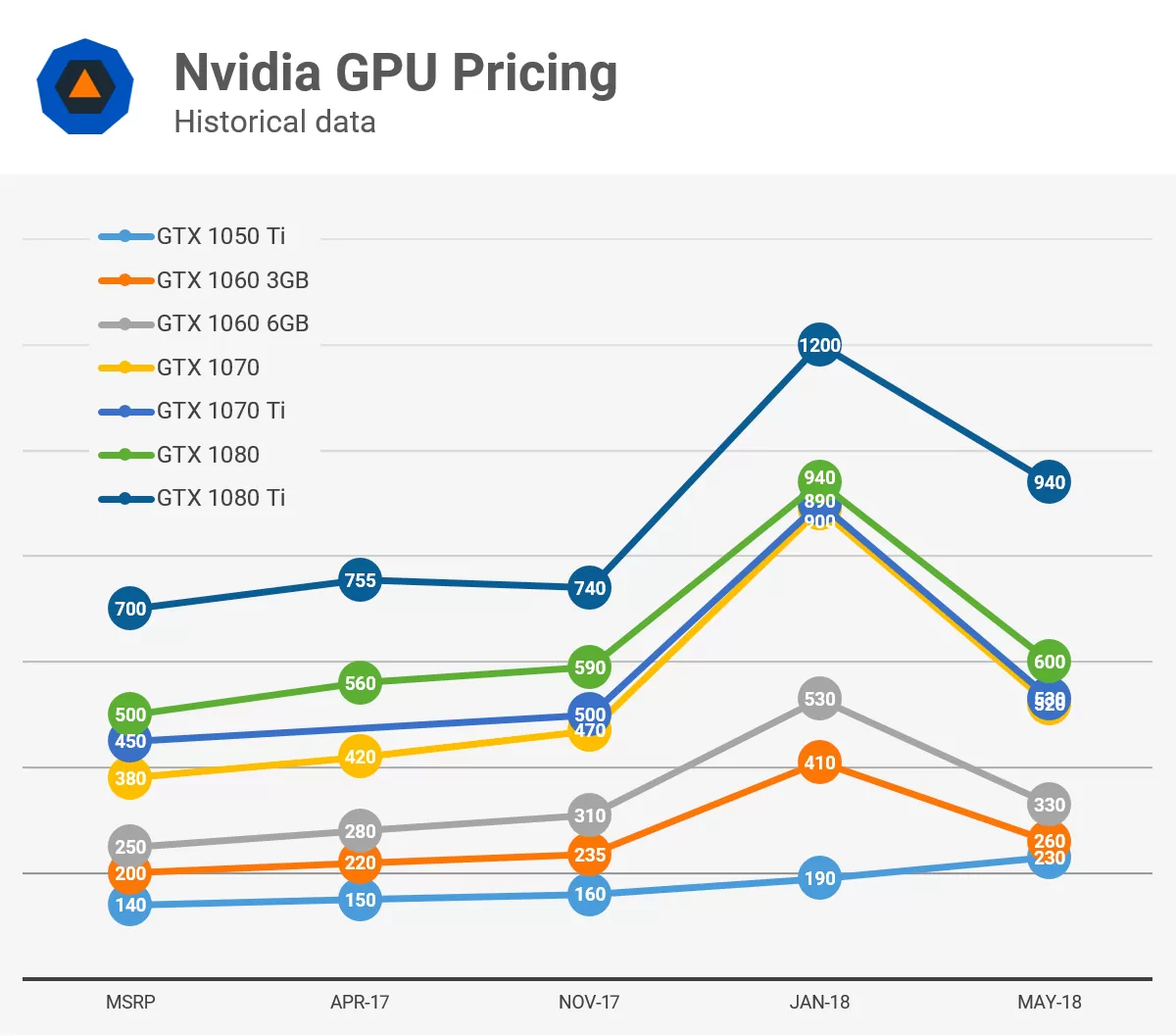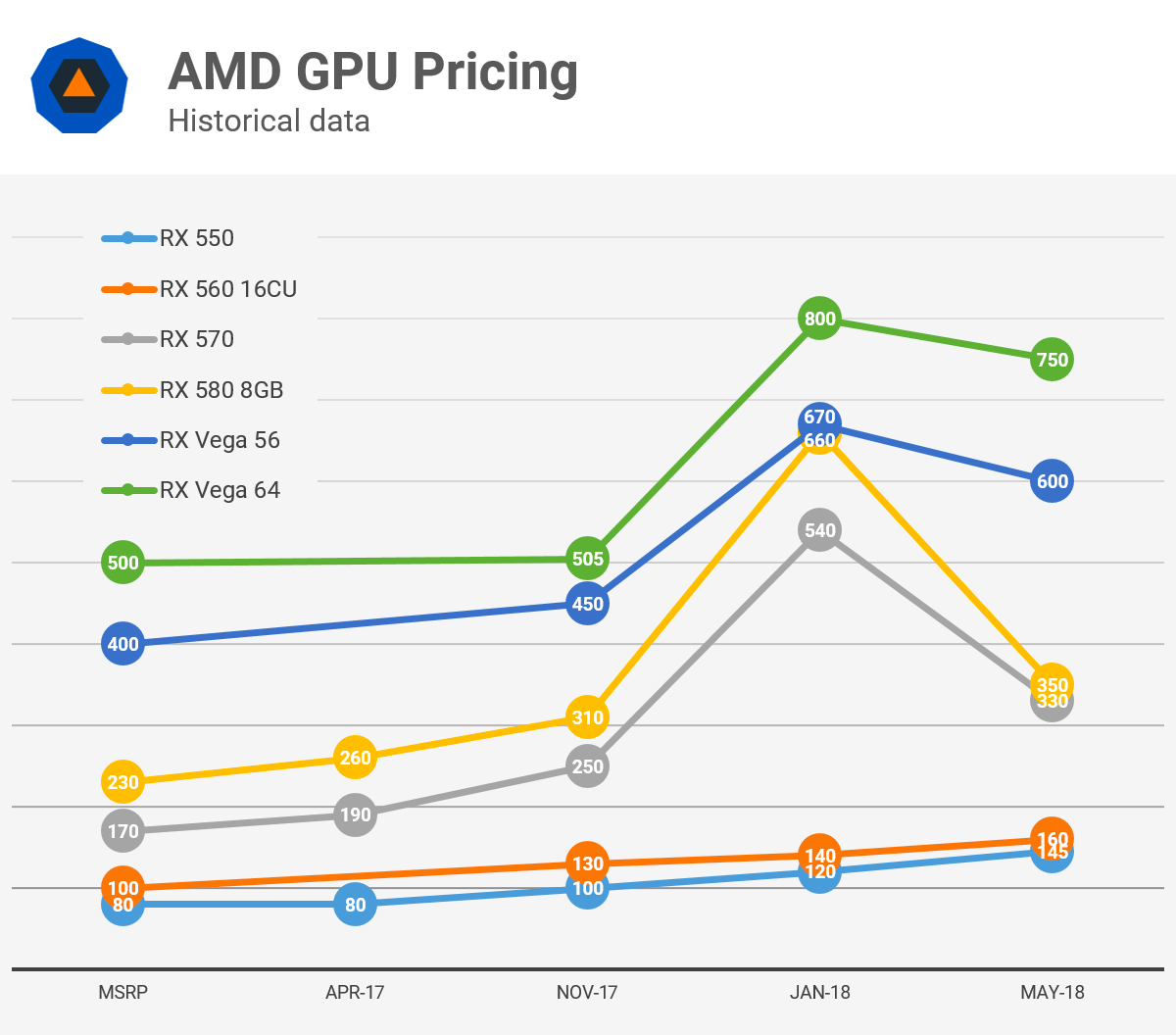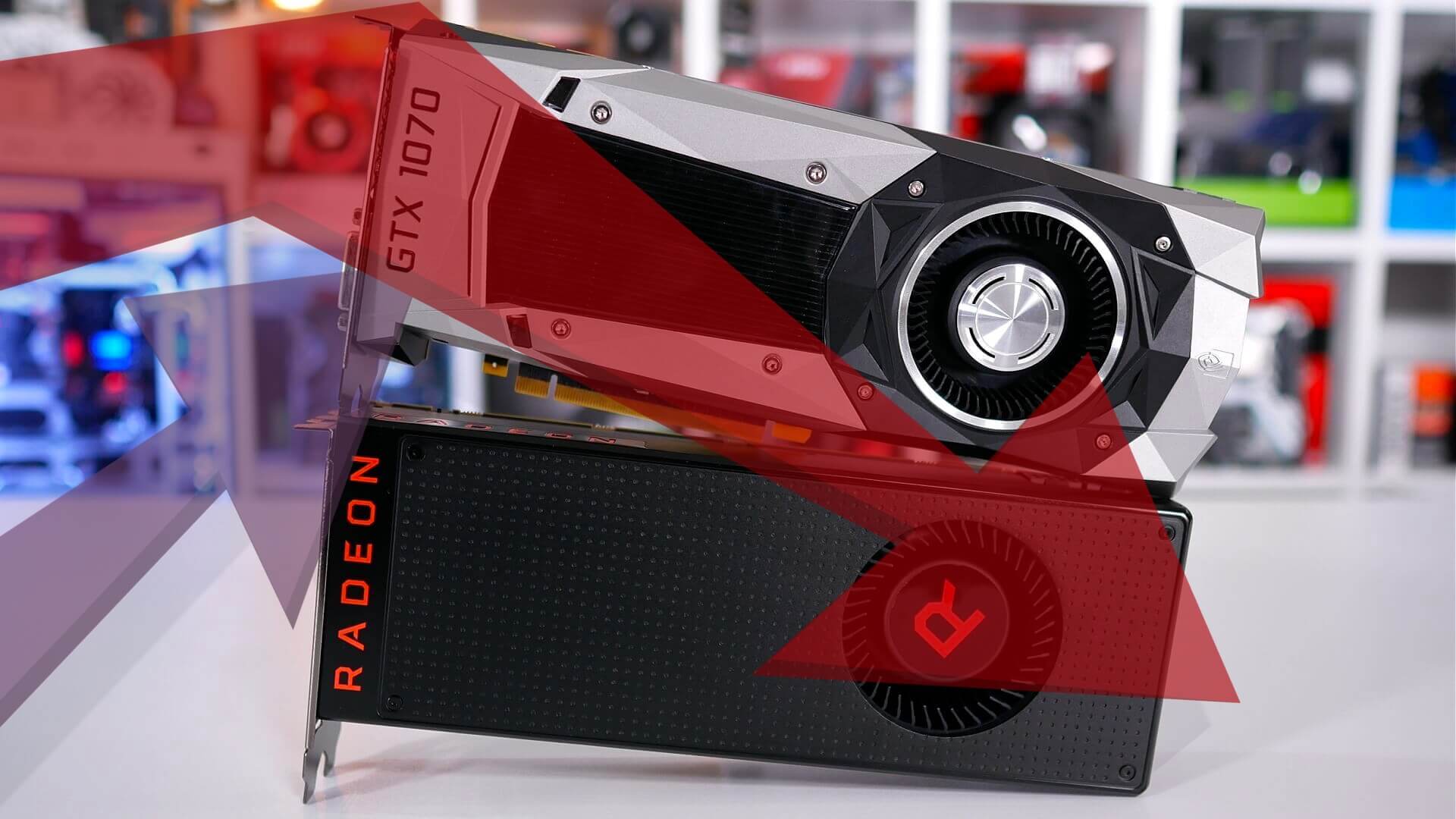One of the most heated issues plaguing the PC building industry at the moment is the price of graphics cards. Over the past 12 months we've seen some absolutely ludicrous prices for popular GPUs; in fact back in January we commented on how massively inflated graphics card prices made it difficult for an enthusiast to upgrade or build a new PC.
Today we're revisiting the issue to see how the GPU market sits right now, what pricing and availability is like relative to various points in the past year, and what the trends in pricing are looking like. We'll also go through some performance figures to show which graphics cards make the most sense to purchase right now.
Also read:
The Best Graphics Cards 2018
For the past year it's nearly impossible to purchase a graphics card at the MRSP as we're sure you're all aware. There are two fairly simple reasons for that: one is that memory is more expensive now than when these GPUs launched, which makes it more expensive to buy the HBM and GDDR5 memory used on these cards, which in turn leads to higher manufacturing costs. The other is the cryptocurrency boom, particularly for Ethereum, which caused much higher than normal demand for GPUs as miners jumped on the crypto pricing surge.
While graphics card pricing was a bit higher than the MSRP throughout most of 2017, prices began skyrocketing in January thanks to a boom in crypto mining profitability and were held at massively inflated values throughout February and early March. The table below shows pricing data points from April 2017, November 2017 and January 2018 for a range of current-gen graphics cards, plus the MSRP of course. These aren't the absolute lowest possible prices you could get at the time, but more of a 'typical' sale price for these GPUs.
And as you can see, in January a range of popular cards like the GTX 1060 and GTX 1070 were typically found at more than double their MSRP. It was even worse on the AMD front with the RX 570 and RX 580 often going for triple the MSRP, while the relatively new Vega cards were expensive and almost always out of stock. You know things are bad when a mere RX 580 is being sold for well over the MSRP of a GTX 1080 or Vega 64.
| MSRP | April 2017 |
November 2017 | January 2018 |
Current Typical (May 2018) |
Current Best (May 2018) |
|
| GeForce GTX 1050 Ti |
$140 | $150 | $160 | $190 | $230 | $190 |
| GeForce GTX 1060 3GB |
$200 | $220 | $235 | $410 | $260 | $230 |
| GeForce GTX 1060 6GB |
$250 | $280 | $310 | $530 | $330 | $300 |
| GeForce GTX 1070 |
$380 | $420 | $470 | $890 | $520 | $470 |
| GeForce GTX 1070 Ti |
$450 | $500 | $900 | $530 | $500 | |
| GeForce GTX 1080 |
$500 | $560 | $590 | $940 | $600 | $550 |
| GeForce GTX 1080 Ti |
$700 | $755 | $740 | $1,200 | $940 | $900 |
| Radeon RX 550 |
$80 | $80 | $100 | $120 | $145 | $115 |
| Radeon RX 560 16CU |
$100 | $130 | $140 | $160 | $140 | |
| Radeon RX 570 |
$170 | $190 | $250 | $540 | $330 | $260 |
| Radeon RX 580 8GB |
$230 | $260 | $310 | $660 | $350 | $300 |
| Radeon RX Vega 56 |
$400 | $450 | $670 | $600 | $600 | |
| Radeon RX Vega 64 |
$500 | $505 | $800 | $750 | $700 |
So how are things looking at the moment? The good news is prices have dropped significantly since the early parts of 2018, and it's much easier to find graphics cards in stock than it was back then. You can see that while prices still aren't fantastic, they are much closer to the MSRP than it has been for the entire year, particularly for Nvidia GPUs.
Cards like the GTX 1060 6GB that used to sell for more than $500 in early 2018 can now be found for as low as $300; still $50 over the MSRP but much more affordable than it was.

And I should note here that for this analysis I did not factor in Nvidia's recent release of Founders Edition GPUs at the MSRP through their official store. It was possible to get an Nvidia card for less than the prices listed in these charts for about a day, but stock sold out pretty quickly. Instead these prices were collected after those Founders Edition cards sold out, and we only looked at cards that were actually in stock.
AMD graphics card prices have also come down but they were more heavily inflated during the early parts of 2018, so they haven't dropped as close to their MSRPs as Nvidia cards have. Still, a popular GPU like the RX 580 used to cost around $660 and it can now be found for more like $350.

There are a few strange exceptions to the price drops that we've seen over the past month or so. Entry-level cards like the GeForce GTX 1050 Ti and both the Radeon RX 550 and RX 560 are actually more expensive now than they have ever been, and in a best case scenario you'll find prices that are no different to January. Memory prices more heavily affect entry-level cards, and I think this could be why these more budget-friendly options are still well above the MSRP.
Top-end cards from both AMD and Nvidia have come down in price, but not by as much as other GPUs. The GTX 1080 Ti, for example, is cheaper than it was in January, but still several hundred dollars more expensive than in 2017. AMD Vega cards are a bit cheaper now than in January, but they're still well above the MSRP and while they are in stock, there are only a few options on the market right now.

Looking at the percentage change in pricing illustrates how the market has changed from January to today. Mid to upper-end graphics cards have dropped in price by 35 to 45 percent in a couple of months, while Vega cards are roughly 10 percent cheaper and the GTX 1080 Ti has dropped by 22 percent. Meanwhile, more mainstream offerings have increased by as much as 21 percent.
While GPU prices are currently higher than they were in the late parts of 2017, there is a clear downward trend. PC Part Picker's GPU pricing trend charts illustrate this downward slope better than our tables do, with most of those mid and upper-end cards showing noticeable downward trends over the last month or two. So while we're not quite at 2017 level pricing just yet, barring no sudden explosion in the mining market it shouldn't be too long before we're back to that point.
Unfortunately, when comparing current GPU pricing to the MSRP, the picture doesn't look anywhere near as nice. Even when taking the lowest available price for these GPUs, most prices are inflated by anywhere from 10 to 53 percent, with an average price hike of 31 percent...

Again, AMD GPU prices are inflated by larger amounts than Nvidia cards at the moment which is bad news for those that are interested in a card from Team Red. And thanks to the high pricing of HBM and GDDR5 I'm not sure we'll ever get back to the MSRP, which is pretty disappointing considering a lot of these cards are now years old.
The GTX 1080, for example, launched in May 2016 and currently sits 10 percent higher than its launch price two years later. Usually this sort of card would be well under the launch price by now. The RX 580 is basically a rebranded RX 480, which originally launched in June 2016 and I'm not sure has ever been seen at the MRSP outside of a few brief moments.
Our only real hope for better GPU prices at this point is an entirely new generation of cards, which hopefully should become a reality (at least as far as Nvidia is concerned) later this year.
Best Value: Price vs. Performance Analysis
Let's look at which cards make the most sense to buy right now. After all, there's no point looking at GPU review or pricing analysis from several months ago or even last year, as everything has changed since then. We've haven't seen the need to re-benchmark these cards, instead using data we've collected from previous reviews. If you're interested in a more in-depth look at the performance of these cards, there's plenty of content to be found here that will give you a great idea of how these cards stack up.
We're going to show six modern titles at 1440p with Ultra settings or thereabouts, in both the raw performance you can expect along with 'dollar per frame' values that will illustrate which cards are the best value using today's typical sale prices you saw earlier.


The first game we have is Far Cry 5, which is well optimized for both Nvidia and especially AMD graphics cards. It's no surprise, then, that AMD's line-up is strong value in this game despite being priced higher above the MSRP than Nvidia cards.
At around $350 the standout is the RX 580 which provides a lower cost per frame than the GTX 1060 6GB, though the 3GB 1060 is the best value card overall at its $260 price point. Moving up the stack we'd recommend the GTX 1070 Ti narrowly over Vega 56, though both are good buys, while at the higher end the GTX 1080 is stronger value than Vega 64. In the battle of entry-level cards the RX 560 is great value, much more so than the GTX 1050 Ti.


In Destiny 2 things are more heavily skewed in favour of the green team. The GTX 1060 3GB is once again the standout for value, while the 6GB variant is better than the RX 580. Vega cards don't make a lot of sense from a value perspective in this title, falling well behind the GTX 1070 and GTX 1080 in cost per frame. At the lower-end of the scale, the RX 560 16CU is again a better option than the GTX 1050 Ti.


In Star Wars Battlefront 2 we don't have current data for some of the lower-tier cards but will continue to look at some of the more popular mid-tier and high-end options. In this highly-optimized title the RX 580 just edges out the GTX 1060 as the better value option, while once again the higher-end Nvidia cards present better value than Vega, particularly the GTX 1070 Ti which is a great buy right now. That said, the GTX 1080 Ti is the worst value right now in this title.


Assassin's Creed Origins is just one of those games that makes more sense to run on Nvidia hardware. The GTX 1060 6GB is better value than the RX 580 by quite a margin, and then that grows when comparing the GTX 1070 Ti and GTX 1080 to AMD's two main Vega offerings. The Vega 64 air cooled model is really bad value in this game in particular.


Middle-earth Shadow of War narrowly favors Nvidia in the battle of the mid-tier cards, though both the GTX 1060 6GB and RX 580 are great options for this game. Again, at the higher-end of the spectrum, it's Nvidia that takes the crown with both the GTX 1070 Ti and GTX 1080 offering the best value relative to Vega.


Wolfenstein II is the last game we're looking at, and it's a title that runs well on AMD hardware in particular. The RX 580 in this game is a much better buy than the GTX 1060 6GB, while Vega 56 competes strongly with the GTX 1070 Ti from a cost per frame perspective. We'd still go for the GTX 1080 over Vega 64 though, which is where the value proposition swings back into Nvidia's favour.

When taking the average cost per frame across the last four games we looked at, the GTX 1060 6GB narrowly edges out the RX 580 as the best value GPU, though if you can find an RX 580 for $300 then it swings back in favour of the RX 580. For upper-tier cards, the GTX 1070 Ti is the best value, providing a better cost per frame than both the GTX 1070 and Vega 56, then the GTX 1080 is clearly better value than Vega 64.
The overall best value card appears to be the GeForce GTX 1060 3GB at the moment, with the RX 560 16CU offering significantly better value than the GTX 1050 Ti if you're after something cheaper.

In an alternate reality where GPUs are available at the MSRP, this is the cost per frame you're looking at when averaging the Far Cry 5 and Destiny 2 results. What a shame that AMD graphics cards can't be found anywhere near their MSRP.
The good news is if you are thinking of purchasing a graphics card right now, there seems to be plenty of stock of all models through retailers like Newegg and Amazon, though top-end cards like Vega 64 are a bit harder to find.
Whether you should buy a new graphics card right now or simply wait for the potential launch of new GPUs towards the end of the year is harder to say. We don't know what Nvidia or AMD's next-gen line-ups will look like, and there's every chance that mid-tier cards like the GTX 1060 won't be superseded when these new GPUs come out.
And then there's also the continuing downtrend of GPU prices to consider. If you wait a month, you might getter price on a GPU you are after, but then you'll be stuck on your old card for longer. It's definitely a far better choice to upgrade now than it was back in January when GPU prices were at their craziest though, so if you have been waiting since the start of the year, there's no better time than now.
